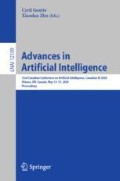Abstract
In this paper, we propose a joint model, composed of neural and linguistic sub-models, to address classification tasks in which the distribution of labels over samples is imbalanced. Different experiments are performed on tasks 1 and 2 of the DEFT 2013 shared task [10]. In one set of experiments, the joint model is used for both classification tasks, whereas the second set of experiments involves using the neural sub-model, independently. This allows us to measure the impact of using linguistic features in the joint model. The results for both tasks show that adding the linguistic sub-model improves classification performance on the rare classes. This improvement is more significant in the case of task 1, where state-of-the-art results are achieved in terms of micro and macro-average F1 scores.
Access this chapter
Tax calculation will be finalised at checkout
Purchases are for personal use only
References
Amini, H., Farahnak, F., Kosseim, L.: Natural language processing: an overview. In: Frontiers in Pattern Recognition and Artificial Intelligence, vol. 5, Chap. 3, pp. 35–55. World Scientific, June 2019
Xuan Bach, N., Khuong Duy, T., Minh Phuong, T.: A POS tagging model for vietnamese social media text using BiLSTM-CRF with rich features. In: Nayak, A.C., Sharma, A. (eds.) PRICAI 2019, Part III. LNCS (LNAI), vol. 11672, pp. 206–219. Springer, Cham (2019). https://doi.org/10.1007/978-3-030-29894-4_16
Bogdanova, D., Foster, J., Dzendzik, D., Liu, Q.: If you can’t beat them join them: handcrafted features complement neural nets for non-factoid answer reranking. In: Proceedings of the 15th Conference of the European Chapter of the Association for Computational Linguistics: Volume 1, Long Papers, pp. 121–131 (2017)
Bost, X., et al.: Systémes du LIA à DEFT 13. arXiv preprint arXiv:1702.06478 (2017)
Charton, E., Meurs, M.J., Jean-Louis, L., Gagnon, M.: Using collaborative tagging for text classification: from text classification to opinion mining. Informatics 1(1), 32–51 (2014)
Cho, K., et al.: Learning phrase representations using RNN encoder-decoder for statistical machine translation. In: Proceedings of the 2014 Conference on Empirical Methods in Natural Language Processing (EMNLP 2014), Doha, Qatar, pp. 1724–1734, October 2014
Chung, J., Gulcehre, C., Cho, K., Bengio, Y.: Empirical evaluation of gated recurrent neural networks on sequence modeling. In: NIPS 2014 Deep Learning and Representation Learning Workshop, Montreal, Canada, December 2014
Collin, O., Guerraz, A., Hiou, Y., Voisine, N.: Participation de orange labs à deft 2013. Actes du neuvième DÉfi Fouille de Textes, pp. 67–79 (2013)
Devlin, J., Chang, M.W., Lee, K., Toutanova, K.: BERT: pre-training of deep bidirectional transformers for language understanding. In: Proceedings of the 2019 Conference of the North American Chapter of the Association for Computational Linguistics: Human Language Technologies (ACL/HLT 2019), pp. 4171–4186. Minneapolis, Minnesota, June 2019
Grouin, C., Paroubek, P., Zweigenbaum, P.: DEFT2013 se met à table: présentation du défi et résultats. In: Actes de DEFT. TALN, Les Sables-d’Olonnes, France, 21 juin 2013
Hamon, T., Périnet, A., Grabar, N.: Efficacité combinée du flou et de l’exact des recettes de cuisine. Actes du neuvième DÉfi Fouille de Textes, p. 18 (2013)
Hochreiter, S., Schmidhuber, J.: Long short-term memory. Neural Comput. 9(8), 1735–1780 (1997)
Johnson, J.M., Khoshgoftaar, T.M.: Survey on deep learning with class imbalance. J. Big Data 6(1), 1–54 (2019). https://doi.org/10.1186/s40537-019-0192-5
Krawczyk, B.: Learning from imbalanced data: open challenges and future directions. Prog. Artif. Intell. 5(4), 221–232 (2016). https://doi.org/10.1007/s13748-016-0094-0
LeCun, Y., Haffner, P., Bottou, L., Bengio, Y.: Object recognition with gradient-based learning. Shape, Contour and Grouping in Computer Vision. LNCS, vol. 1681, pp. 319–345. Springer, Heidelberg (1999). https://doi.org/10.1007/3-540-46805-6_19
Loshchilov, I., Hutter, F.: Decoupled weight decay regularization. In: Proceedings of the 3rd International Conference on Learning Representations (ICLR 2019), New Orleans, Louisiana, USA, May 2019
Martin, L., et al.: Camembert: A tasty French language model. arXiv preprint arXiv:1911.03894 (2019)
Oh, J.H., Hong, J.Y., Baek, J.G.: Oversampling method using outlier detectable generative adversarial network. Expert Syst. Appl. 133, 1–8 (2019)
Wang, J., Wang, Z., Zhang, D., Yan, J.: Combining knowledge with deep convolutional neural networks for short text classification. In: International Joint Conference on Artificial Intelligence (IJCAI), pp. 2915–2921 (2017)
Author information
Authors and Affiliations
Corresponding author
Editor information
Editors and Affiliations
Rights and permissions
Copyright information
© 2020 Springer Nature Switzerland AG
About this paper
Cite this paper
Mohammadi, E. et al. (2020). Classification of Rare Recipes Requires Linguistic Features as Special Ingredients. In: Goutte, C., Zhu, X. (eds) Advances in Artificial Intelligence. Canadian AI 2020. Lecture Notes in Computer Science(), vol 12109. Springer, Cham. https://doi.org/10.1007/978-3-030-47358-7_44
Download citation
DOI: https://doi.org/10.1007/978-3-030-47358-7_44
Published:
Publisher Name: Springer, Cham
Print ISBN: 978-3-030-47357-0
Online ISBN: 978-3-030-47358-7
eBook Packages: Computer ScienceComputer Science (R0)

